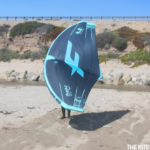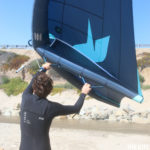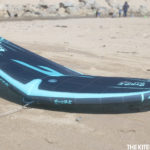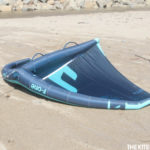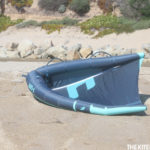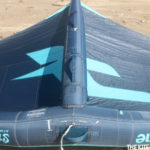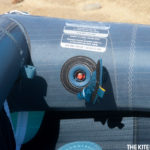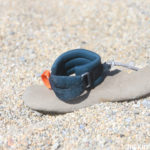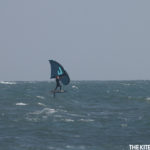Sizes Available: 2.8, 3.5, 4.2, 5m (6m CWC, 7m CWC, 8m CWC)
Sizes Tested: 4.2, 5m
F-One Says:
In the search for thrill and adrenaline, F-One has been looking to make a wing that not only will keep the heritage of the Swing in terms of lightness and comfort but also be incredibly stable and offer great performance as well as huge wind range. From light to high winds, you will discover the full potential of the Strike. Thanks to its unique design and construction, the sensations on the water are unique.
The work done on the control of the deformation of the wing offers more power, fantastic upwind performances, stability and control. This feeling of control will allow you to push the Strike into jumps and air rotations. You are in total comfort at all time, the Strike has the perfect traction balance between your two arms. The handles are perfectly placed, and you won’t suffer from too much pull on your back arm on the long legs. Going upwind has never been so efficient. The impressive stability of the Strike will make you forget about it when in freefly surfing wind swells.
Visit for more info: www.f-one.world/product/strike/

TKB Says:
Three years into the sport of wingsurfing, the release of the Strike presents two key questions for the introduction of F-One’s second generation wing. Is the Strike better than the Swing V1? And with the recent introduction of the Swing V2, what type of riding is the Strike designed for?
Type of inflation: Push Button inflation / boom dump valve
Number of boom handles: 2 center handles
Y handles: None
Wrist leash style: Closed-loop cinch
Window/Coverage: None

There are a number of significant changes in the Strike that make some substantial improvements over the Swing V1. The handles have been completely redesigned; instead of three handles along the boom, the Strike features two handles that have a much wider stance. The Strike features a gooseneck boom. Instead of a straight tube, the boom has a bend and features shaping that leads to both a stiffer canopy and better ergonomics for riding. The Strike also gets the introduction of a release valve on the boom for much quicker deflation. Inflation still occurs on the leading edge through the high-flow push-button valve (just remember to close the valve on the boom first or you will be pumping forever), but now the boom deflates much faster than the Swing V1. The wrist leash is new this year too. It uses the same cinch system that F-One pioneered on the V1, but has more padding and is a bit smaller. You get the picture: There have been a ton of changes in this version, with all modifications making forward improvements to performance, durability and feel.

On our first session with the new design, we noticed significant improvements to the Strike’s airframe rigidity. F-One continues to have the canopy tension design on lockdown, but the new curved boom strut is designed to reconnect with the latter part of the sail plan which makes for excellent pumping and response. The Strike’s new leading edge and boom seem to point higher in the wind, making the Strike feel much more efficient while going upwind. Whereas the Swing V1 would hit a wall going upwind, the Strike seems to want to penetrate further forward with a significant release of pressure on your arms. This seemed to lead to less fatigue over the course of a session and certainly made long slogs back upwind significantly less painful while allowing the Strike to handle overpowered situations significantly better. The Strike seems to move the center of effort farther forward and this tends to make the power delivery on the Strike more on/off compared to the Swing V1. If the Swing V1 likes to pull at any angle, the Strike is more sensitive to how you sheet the boom in or out. Is this bad? No, we think this is good because it handles a wider range of wind and is more efficient for riders that can feel the tuning of the wing.

The new handles are a big change but a welcomed mod to the previous three-handle layout. With the Swing V1, the middle handle was only helpful on your first week of wingsurfing, but after that, you almost never used it unless you were confused. With only two handles on the Strike, our hands always landed in the right place and without thinking. Since the handles have a wider stance, you can move your hand forward or back to fine-tune your balance point on the wing; it seemed like our technical handwork was far easier as we attempted new transitions””our hands connected to a handle much quicker and with fewer misses. The handles use the same EVA-infused webbing as the Swing V1, which is great because that was one of our favorite designs on the market.
The consensus on the Strike was that it gives you a little bit more range. The stiffer airframe yields better pumping performance, yet the Strike is just as maneuverable and balanced as the previous model. Since the Swing V1 was one if not the lightest wings on the market, there was concern that the additional reinforcements in the Strike would make it less maneuverable and detract from its hovering abilities. The Strike’s difference in weight turned out to be very small, so it remains to be a very nimble wing that responds very easily to your inputs without a ton of energy. In terms of hover, the Strike seems to have just a little less positive lift while chasing waves, but it’s almost unnoticeable.

At the end of the day, the Strike is a huge step forward in wing design for F-One that accomplishes what we think is probably one of the most challenging aspects of a redesign. The Strike takes everything that we loved about the Swing V1, while chiseling away at its weaknesses and presenting a control interface that is familiar yet significantly more intuitive. The Strike is a huge improvement with its stiffer airframe for riders who mow the lawn, jump and do freestyle. For riding waves, the Strike is a good option but with the introduction of the Swing V2, there’s an ongoing debate of which wing gets our vote for foil surfing (see the Swing V2 review for comparison).

With over 112 products reviewed, get the digital version of our 2021 Gear Review Guide that puts all the latest products reviews in one easy to access and searchable guide. Want a low-v bar with a durable PVC coated throw line and soft padded bar ends? Use our guide to stay on top of gear developments and find the exact piece of equipment to match your style.
*Already a subscriber or purchased our 2021 Gear Review Guide in the fall? Your guide has been updated to our latest version in your Tkb library. Log into your account to read the latest reviews.



